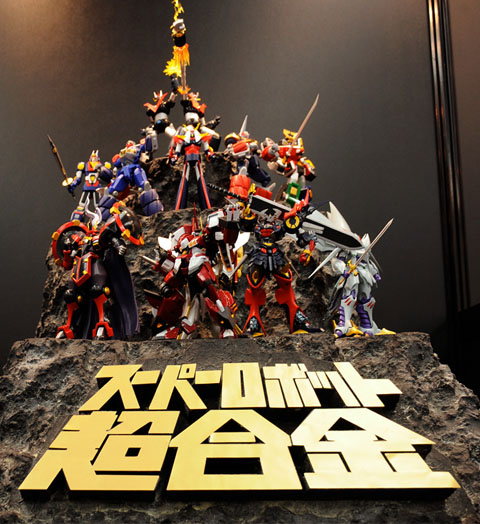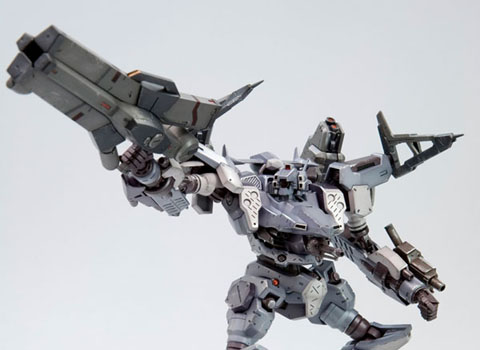
Over at AmiAmi they have some nice coverage surrounding the announcement of a new mecha toy line from Bandai, which will be called Super Robot Chogokin. This will be a smaller scale and more price friendly range of toys to supplement the flagship Soul of Chogokin line. The reasoning behind this is most probably down to the increasing popularity of Kaiyodo’s Revoltech toys not to mention Bandai’s own success with the Robot Damashii range. In short, consumers now prefer smaller and more durable toys that can be played with as well as dynamically posed without having to pay the GDP of a small country.
From a gaming standpoint, this new Super Robot Chogokin line will also sport multiple “original generation” entries from the Super Robot Wars games. With the Alteisen being shown prominently in the coverage thus far. Considering the cost of the other Soul of Chogokin variants not mention the scarily fragile Volks figures, this new range sounds spot on for the gaming populace.




Over at GA Graphic they’ve previewed the upcoming VF Hi-Metal VF-1J toy. The VF-1J, specifically Hikaru Ichijoe’s variant (which this toy is of), is actually quite an important design in the grand scheme of things. Simply due to the fact that it pretty much visually defined the original Macross and subsequently Robotech too. It’s very much an iconic piece of mecha design, if only for the fact that it marked a turning point on how transforming mecha were functionally portrayed.
This had a palpable outcome in terms of toy production as well, as the original Valkyrie toys were wonderfully tactile and beefy with it. Bandai, it seems, are keen to return to that; as the VF Hi-Metal range is technically a reboot of an older toyline. However, the recent Fire Valkyrie toy they released didn’t have much metal in the frame really and also featured a fair amount of parts swapping, this being disappointing when their competitors (like Yamato) have been doing such a brilliant job. Admittedly, Bandai are pricing this much less and are if anything trying to oust Kaiyodo’s Revoltech attempts. The boasted articulation does sound impressive though; a double joint for the elbow for wider articulation of the arm, pull-out mechanisms implemented for the pelvis joint allowing the legs to spread wider for more stable standing, an improved design for the ankle allowing the toy’s feet to be able to touch the surface better, a new the pelvis and ankle joint design to make difficult poses like kneeling possible and the knee joint can be turned horizontally to create lovely poses for the legs in GERWALK mode. Despite the size, the toy will also feature retractable hands too, which is pretty cool.
Naturally, the VF-1J has graced many a game over the years; with the two recent PSP games Macross Ace and Ultimate Frontier being notable. Though our favourite iteration is probably either in Another Century’s Episode 3, as that included the armored variant. In any case, this new VF-1J toy is released in June for 5775 yen and you can pre-order it here.




Certain mecha designers have quite the reputation for pushing boundaries, not only in terms of the technical veracity of their craft but also in regards to the subsequent engineering of the related merchandise. Hajime Katoki is unique in many regards, as he not only helms various toy and kit lines at Bandai but also for being a cheeky scamp. Katoki is also one of the most important mecha designers when it comes to gaming, as he wrestled what was once an incompatible and wayward discipline with the stringent limitations of polygon counts to pen the original VR designs for the ground breaking Virtual On.
So when, after nearly a decade, Katoki was announced to be designing an all new Gundam to grace the UC timeline many people got quite excited. However, the initial reveal of the Unicorn Gundam was a clever ruse; as it showed only Unicorn mode. So not very Gundamy at all really, not until Destroy mode was revealed to the expectant throng with its gilted V-fin and pink psycho-frame innards was it obvious that the Unicorn had been a Gundam all along. Katoki had managed to design something that was, yet again, amazingly intricate but obviously tactile.
Unsurprisingly, the Unicorn made it into the recent Gundam vs Gundam Next and the PSP port Next Plus, along with the its first nemesis the Kshatriya. The Unicorn is a potent unit in the game as well and when in Destroy mode can undertake some pretty epic melee combos.
After much fanfare though, Gundam Unicorn has finally started its animated run as well. To commemorate this event, Katoki has literally fired up one of his toy lines to make the the ultimate toy based incarnation of his design.




Over at Moeyo (link slightly NSFW), they’ve covered the recently released 1/72 scale Stasis kit by Kotobukiya from Armored Core For Answer. As per their usual standard, Kotobukiya have excelled themselves yet again in terms of the sculpt, as the design itself is really quite intricate (despite looking deceptively streamlined). The only downside about this design, in the game at least, is that the parts aren’t exactly what you’d call aesthetically sympathetic. In that you can functionally attach the head, arms, legs and core to other parts they rarely “look” right. Admittedly, some would argue that this is an issue with most of the parts and designs in Armored Core but due to For Answer sharing three named designers (Shoji Kawamori, Kazutaka Miyatake and Makoto Kobayashi), not to mention the in-house art staff, there wasn’t really a unified art style in the same sense as the older games (which had designs mostly penned by Kawamori). In any case, this kit looks marvelous and the design, despite the above, is actually one of our favourites too.




For the Armored Core inclined, this is quite an important kit. If only for the fact that it defined and adorned the original Armored Core 3 Silent Line’s box cover – a game we rate as being the best Armored Core game of all time (something the recent PSP port really fails to live up to). Not only did this design equip the lethal Karasawa laser rifle but also the highly controversial stealth extensions (which were banned in all Japanese tournaments in case you were wondering). Despite sharing the same core as the updated Nineball, this is an all new kit. Like with all the Kotobukiya kits, all the parts are interchangeable from other mecha in the same range and the sculpt is superlatively good as well. This kit is out in August and will be charged at the very reasonable price of 4,725 yen. Here’s the original game’s opening and it features the above design quite prominently too.
Spoiler
[flash http://www.youtube.com/watch?v=os_gG0jLna4]
[collapse]




If you’re at all into the nerdy hardcore world of Jumbo Machinder collecting, then this might be of interest. If you’re just a regular gamer though, wondering what these crazy large toys are all about, well in many ways they were the nascent influence for games like Super Robot Wars. The original toys were made by then Japanese toy giant Popy, who later merged with Bandai. Popy also birthed the Chogokin line of toys, with the term referencing the “super alloys” that graced many super robot anime shows of the mid to late 70’s. A line Bandai resurrected a decade ago with their Soul of Chogokin range of toys.
The Jumbo Machinders were unique due to their size and the fact that play fights between robots would inevitably and awesomely break out. Apparently, this was one of the initial and main inspirations for the first Super Robot Wars game that appeared way back in 1991 on the GameBoy. Even the term “chogokin” makes its way into multiple Super Robot Wars games too.
If you fancy a stupidly large Jumbo Machinder of your own, then you’d do well to pick up the new Mazinger Z. It’s pretty damn pimp.























